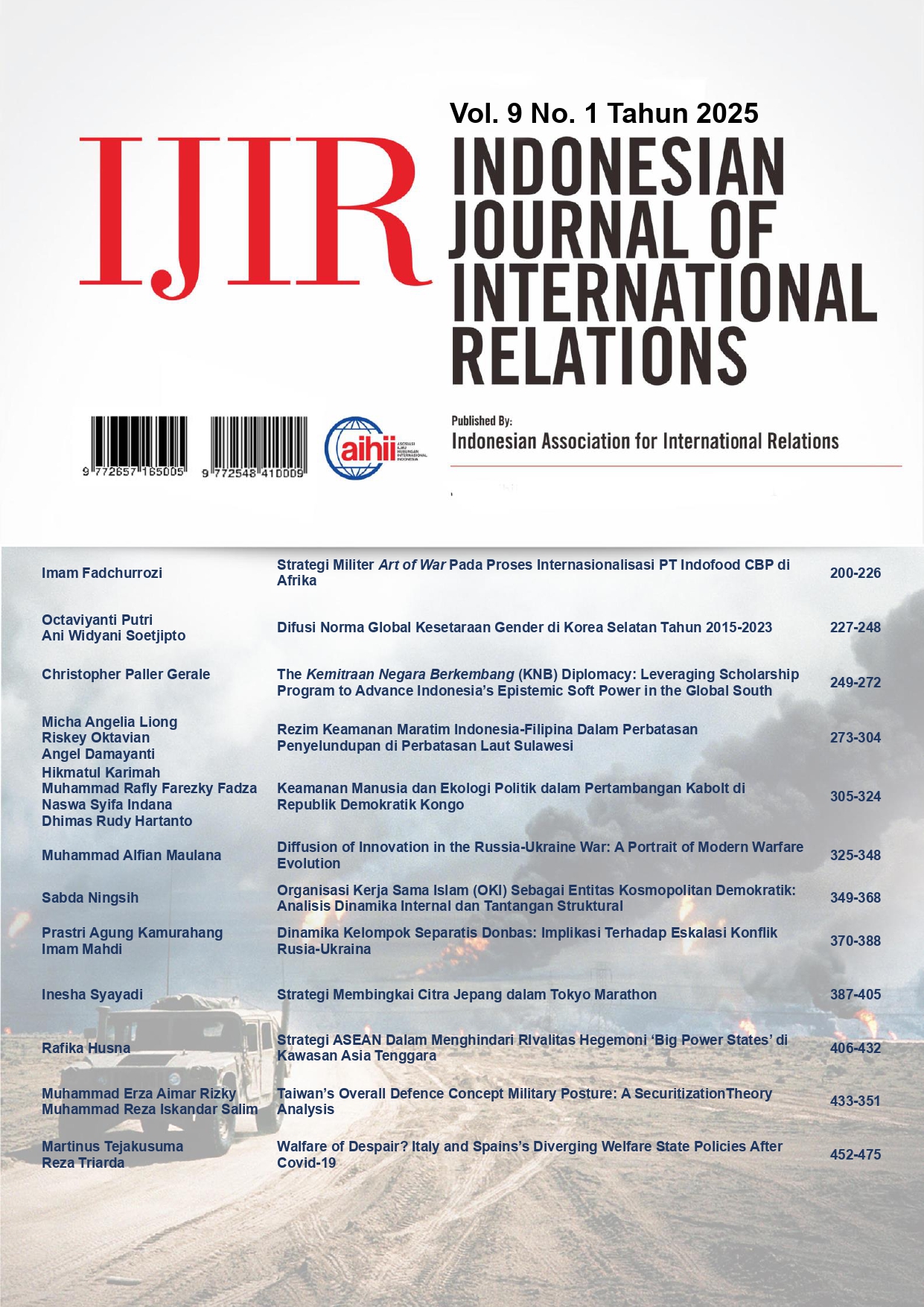TAIWAN’S OVERALL DEFENCE CONCEPT MILITARY POSTURE: A SECURITIZATION THEORY ANALYSIS
Abstract
The entrance of President Tsai Ing-Wen’s party, the DPP, into power marked a shift in Taiwan’s attitude towards China. This comes as a response to China’s increasingly threatening rhetoric and incursion on Taiwan’s de facto sovereignty in the latter half of the 2010s. Taiwan’s military chief during Tsai’s presidency, Admiral Lee Hsi-Min, introduced the Overall Defense Concept (ODC) during his tenure as the basis for reform in the armed forces posture. The introduction of ODC signals the acceptance of Taiwan’s military establishment on China as the primary existential threat. We analyzed the securitizing process with a version of securitization theory from Thierry Balzacq. To operationalize this theory, this paper will use a qualitative approach using literature study. We hypothesize that the change in Taiwan’s security officials' perception towards China and the adoption of ODC is caused by the increasingly aggressive approach by Beijing towards Taipei.
Downloads
References
Balzacq, T. (2010). Securitization Theory. Routledge. https://doi.org/10.4324/9780203868508
Balzacq, T. (2005). The Three Faces of Securitization: Political Agency, Audience and Context. European Journal of International Relations, 11(2), 171–201. https://doi.org/10.1177/1354066105052960
Brown, D. G. (2017). Governing Taiwan is not easy: President Tsai Ing-wen’s first year. Brookings. https://www.brookings.edu/articles/governing-taiwan-is-not-easy-president-tsai-ing-wens-first-year/
Bush, R. C. (2016, May 23). Tsai’s inauguration in Taiwan: It could have been worse. Brookings. https://www.brookings.edu/articles/tsais-inauguration-in-taiwan-it-could-have-been-worse/
China’s might is forcing Taiwan to rethink its military strategy. (2019, January 26). The Economist. https://www.economist.com/asia/2019/01/26/chinas-might-is-forcing-taiwan-to-rethink-its-military-strategy
Chu, C. (2024, April 26). Taiwan Revives Civilian Leadership of Defense. The Diplomat. https://thediplomat.com/2024/04/taiwan-revives-civilian-leadership-of-defense/
Cole, J. Michael. Cross-strait relations since 2016: The end of the illusion. London, UK: Routledge, Taylor & Francis Group, 2020.
Cole, Bernard D. Taiwan’s security: History and prospects. London, UK: Routledge, 2006.
Diamond, Larry, and James O. Ellis. “Deterring a Chinese Military Attack on Taiwan.” Bulletin of the Atomic Scientists 79, no. 2 (2023): 65–71. https://doi.org/10.1080/00963402.2023.2178166.
Dotson, J. (2022, November 30). Taiwan’s Naval Shipbuilding Programs Point towards an Evolving Direction in Defense Policy. Global Taiwan Institute. https://globaltaiwan.org/2022/11/taiwans-naval-shipbuilding-programs-point-towards-an-evolving-direction-in-defense-policy/
Duchâtel, Mathieu. (2022). An Assessment of China’s Options for Military Coercion of Taiwan. In Wuthnow, J., Derek, G., Phillip C., S., Andrew, S., & Andrew N. D., Y. (Eds.). (2022). Crossing the Strait: China’s Military Prepares for War with Taiwan. National Defense University Press, 2022.
Dreyer, J. T., & deLisle, J. (2021). Taiwan in the era of Tsai Ing-wen: Changes and Challenges. Routledge.
Flynn, B. (2024). An Untenable Status Quo: Structural Change and the US-China-Taiwan Relationship. Global Taiwan Institute. https://globaltaiwan.org/wp-content/uploads/2024/04/OR_Flynn_An-Untenable-Status-Quo.pdf
Gomez, E. (2023). Taiwan’s Urgent Need for Asymmetric Defense. Cato Institute. https://www.cato.org/policy-analysis/taiwans-urgent-need-asymmetric-defense#chinas-growing-military-power
Gregson, W., & Dotson, J. (2023, May 17). Porcupine or Honey Badger?: The “Overall Defense Concept” and Asymmetry in Taiwan’s Defense Strategy. Global Taiwan Institute. https://globaltaiwan.org/2023/05/porcupine-or-honey-badger-the-overall-defense-concept-and-asymmetry-in-taiwans-defense-strategy/
Huang, P. (2024, May 2). Taiwan’s Military Has Flashy American Weapons but No Ammo. Foreign Policy. https://foreignpolicy.com/2020/08/20/taiwan-military-flashy-american-weapons-no-ammo/
Hunzeker, M. A., Lanoszka, A., Davis, B., Fay, M., Goepner, E., Petrucelli, J., & Seng-White, E. (2018). A Question of Time. Center for Security Policy Studies.
Kastner, Scott L. “International Relations Theory and the Relationship across the Taiwan Strait.” International Journal of Taiwan Studies 1, no. 1 (February 20, 2018): 161–83. https://doi.org/10.1163/24688800-00101009.
Kastner, Scott L. “Is the Taiwan Strait Still a Flash Point? Rethinking the Prospects for Armed Conflict between China and Taiwan.” International Security 40, no. 3 (January 2016): 54–92. https://doi.org/10.1162/isec_a_00227.
Lau, S. (2024, January 13). Taiwan is too slow learning from Ukraine war, ex-top commander says. POLITICO. https://www.politico.eu/article/taiwan-ukraine-china-leehsi-ming-ex-top-commander-says/
Lee, W. (2023). Protests, Pandemic, and Security Predicaments. Springer Nature.
Liao, H. (2023, May 12). Taiwan’s Intangible, Potentially Disastrous Defense Problems. National Defense Magazine. https://www.nationaldefensemagazine.org/articles/2023/5/12/taiwans-intangible-potentially-disastrous-defense-problems
Liu, Tony Tai-Ting, and Tung-Chieh Tsai. “Winter Is Coming: Emerging War in the Taiwan Strait?” The Journal of East Asian Affairs 34, no. 1 (2021): 37–60. http://www.jstor.org/stable/45441180.
McDevitt, Michael. “The Security Situation across the Taiwan Strait: Challenges and Opportunities.” Journal of Contemporary China 13, no. 40 (2004): 411–25. https://doi.org/10.1080/1067056042000213328.
Rickards, J. (2024, March 14). From the Black Sea to the Taiwan Strait: Lessons in Resilience. Taiwan Business TOPICS. https://topics.amcham.com.tw/2024/03/from-the-black-sea-to-the-taiwan-strait-lessons-in-resilience/
Sacks, D. (2023, August 30). Taiwan Announced a Record Defense Budget: But Is It Enough to Deter China? Council on Foreign Relations. https://www.cfr.org/blog/taiwan-announced-record-defense-budget-it-enough-deter-china
Schriver, Randall G. A Perfect Storm: Managing Conflict in the Taiwan Strait, October 2013.
Teng, P. (2019, June 26). Taiwan Chief of the General Staff conferred highest military award ahead of retirement. Taiwan News. https://www.taiwannews.com.tw/news/3732486
Thompson, D. (2021). Winning the Fight Taiwan Cannot Afford to Lose. Strategic Forum, (310), 1-14. https://www.proquest.com/scholarly-journals/winning-fight-taiwan-cannot-afford-lose/docview/2597851190/se-2
Walsh. (2023, November). Taiwan Strait: The Ocean’s Most Contested Place. U.S. Naval Institute. Retrieved April 30, 2024, from https://www.usni.org/magazines/proceedings/2023/november/taiwan-strait-oceans-most-contested-place
Wong, Y., Wu, H., & Wang, K. (2016, August 26). Tsai’s Refusal to Affirm the 1992 Consensus Spells Trouble for Taiwan. The Diplomat. https://thediplomat.com/2016/08/tsais-refusal-to-affirm-the-1992-consensus-spells-trouble-for-taiwan/
Wu, Shang-Su. “Taiwan’s Security: Civilian Control and External Threat.” Cogent Arts & Humanities 10, no. 1 (2023). https://doi.org/10.1080/23311983.2023.2220211.
Wuthnow, J., Derek, G., Phillip C., S., Andrew, S., & Andrew N. D., Y. (Eds.). (2022). Crossing the Strait: China’s Military Prepares for War with Taiwan. National Defense University Press, 2022.
Xiying, Zuo. “Unbalanced Deterrence: Coercive Threat, Reassurance and the US-China Rivalry in Taiwan Strait.” The Pacific Review 34, no. 4 (December, 2019): 547–76. https://doi.org/10.1080/09512748.2019.1697353.
Copyright (c) 2025 Muhammad Erza Aimar Rizky, Muhammad Reza Iskandar Salim

This work is licensed under a Creative Commons Attribution-NonCommercial-ShareAlike 4.0 International License.
License
IJIR is fully open access. All articles are immediately and freely available upon publication and licensed under the Creative Commons Attribution-ShareAlike 4.0 International License (CC BY-SA 4.0).
Authors retain copyright. By submitting, authors grant IJIR:
- Right of first publication
- Right to distribute the work under CC BY-SA 4.0
Under this license, others may share, adapt, and use the work, even for commercial purposes, provided proper attribution is given and derivative works use the same license.





















